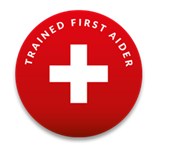First Aid
First Aid
First aid is immediate care for the ill and injured with the intention of preserving life, preventing an injured or ill person’s condition from worsening and supporting the patient emotionally. This may include treating minor injuries or taking charge where an injury or illness requires further treatment by a medical professional until the patient can be taken to hospital.
Adult Basic Life Support
If you suspect someone is unconscious and not breathing / not breathing normally you must immediacy dial 999 and request an ambulance and commence chest compressions.
- High-quality chest compressions
- Start chest compressions as soon as possible.
- Deliver compressions on the lower half of the sternum (‘in the centre of the chest’).
- Compress to a depth of at least 5 cm but not more than 6 cm at a rate of 100-120 a minute.
- Rescue breaths
- If you are trained to do so, after 30 compressions, provide 2 rescue breaths.
- Alternate between providing 30 compressions and 2 rescue breaths.
- If you are unable or unwilling to provide rescue breath, give continuous chest compressions.
- Request one of the Queen Mary Automated External Defibrillators (AED)
Automated External Defibrillators (AED)
- An automated external defibrillator (AED) is a lightweight, portable device that delivers a controlled electric shock through the chest to the heart, via two electrodes that are fixed to the casualty’s chest.
- The AED is able to detect the rhythm of the heart, and it can deliver a shock that can restore normal heart rhythm.
An AED should be attached to the casualty as soon as it is available.
Contacting the Emergency Medical Services
- I the event of life-threatening emergency situations dial 999 and request an ambulance.
- Inform Security by calling them on 020 7882 3333 and ask them to meet the ambulance and escort the paramedic’s to you.
- Send a colleague to wait outside the building to meet with Security and the paramedic’s.
- As a general you must escort the paramedics to the casualty not the casualty to the paramedics.
Life Threatening Bleeding
Uncontrolled bleeding has been identified as the leading cause of preventable deaths following accidental injury. Blood makes up about 7% of our body weight and an average adult has approximately 5 litres of blood in their body. Time is of the essence to control a catastrophic bleed. A casualty could haemorrhage up to a litre of blood every minute. After 2 minutes they could have lost up to a third of their blood volume leading to shock that they may never recover from.
First Aid for Life Threatening Bleeding [DOC 1,019KB]
First Aiders
 In general, the role of a first aider is to administer first aid in all environments, subject to any local restriction and in accordance with their level of qualification. To know how to secure additional help when needed including efficiently and effectively contacting the emergency medical services.
In general, the role of a first aider is to administer first aid in all environments, subject to any local restriction and in accordance with their level of qualification. To know how to secure additional help when needed including efficiently and effectively contacting the emergency medical services.
First Aid Training
There are several class room accredited first aid course along with self-directed e-learning courses. For full course information please see the HSD Training web page.
First Aid Treatment
- First Aid for Fractures [PDF 266KB]
- Anaphylaxis recognition and first aid treatment [PDF 585KB]
- Anaphylaxis Poster [PDF 469KB]
- Choking First Aid Poster
- First Aid for Burns
- Procedure in the event of a contamination incident
- First Aid for Panic Attacks [PDF 311KB]
- Fainting, Panic Attacks or Something More Serious
- Summer Safety - Be Sun Smart
Further Information
- Administration of First Aid Guidance
- Automated External Defibrillators Guidance
- AED (defibrillator) Locations
- NHS non-emergency help line
- NHS UK
Queen Mary Policy and procedures
Primary Legislation
- Health and Safety at Work, etc Act 1974.
- The Health and Safety (First Aid) Regulations 1981.
- The Social Action, Responsibility & Heroism Act 2015.
For advice and assistance at Queen Mary
contact the H&S Manager / Advisor for your Faculty / PS or the subject lead.
All HSD staff can be contacted via the HSD Helpdesk.